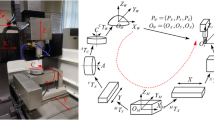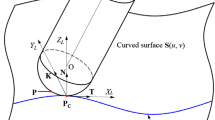Abstract
There is a relatively vast class of tool path optimization methods that minimize cost functions depending on a whole tool path. In these methods, cost functions are usually limited to convex function because the used optimization approaches cannot either handle nonsmooth functions or perform with an acceptable computational time. This paper describes a developed optimization method that finds a sequence of tool orientations that can minimize various cost functions including displacement of machine rotary axes. Every posture, tool feasible orientation can be represented in discrete fashion as nodes of a directed graph in which the edge weights denote an objective. Shortest paths are sought iteratively by applying Dijkstra’s algorithms and narrowing intervals of feasible tool orientations around the previous solution. The developed algorithm is a derivative-free optimization method working in a linear time.
Similar content being viewed by others
References
Marciniak K (1987) Influence of surface shape in admissible tool positions in 5-axis face milling. Comput Aided Des 19:233–236
Jensen C G, Anderson D C (1993) Accurate tool placement and orientation for finish surface machining. J Des Manufacting 3:251–261
Choi B, Park J, Jun C (1993) Cutter-location data optimization in 5-axis surface machining. Comput Aided Des 25(6):377–386
Kruth J P, Klewais P (1994) Optimization and dynamic adaptation of the cutter inclination during five-axis milling of sculptured surfaces. CIRP Annals—Manufacturing Technol 43(1):443–448
Rao N, Ismail F, Bedi S (1997) Tool path planning for five-axis machining using the principal axis method. Int J Mach Tools Manuf 37(7):1025–1040
Morishige K, Takeuchi Y, Kase K (1999) Tool path generation using C-space for 5-axis control machining. J Manuf Sci Eng 121(1):144–149
Jun C S, Cha K, Lee Y S (2003) Optimizing tool orientations for 5-axis machining by configuration-space search method. Comput Aided Des 35(6):549–566
Weinert K, Zabel A, Müller H, Kersting P (2006) Optimizing of nc tool paths for five-axis milling using evolutionary algorithms on wavelets. In: Proceedings of the 8th annual conference on genetic and evolutionary computation. ACM, Seattle, pp 1809–1816
Kim T, Sarma S E (2002) Toolpath generation along directions of maximum kinematic performance: a first cut at machine-optimal paths. Comput Aided Des 34(6):453–468
Castagnetti C, Duc E, Ray P (2008) The domain of admissible orientation concept: a new method for five-axis tool path optimisation. Comput Aided Des 40(9):938–950
Lavernhe S, Tournier C, Lartigue C (2008) Optimization of 5-axis high-speed machining using a surface based approach. Comput Aided Des 40(10-11):1015–1023
Barakchi Fard M, Feng H Y (2009) Effect of tool tilt angle on machining strip width in five-axis flat-end milling of free-form surfaces. Int J Adv Manuf Technol 44:211–222
Munlin M, Makhanov S S (2012) Iterative tool path optimization for five-axis machines with optimal point insertion. Comput Aided Des Appl 9(1):33–41
Hsieh H-T, Chu C-H (2013) Improving optimization of tool path planning in 5-axis flank milling using advanced {PSO} algorithms. Robot Comput Integr Manuf 29:3–11
Chu C-H, Kuo C-L (2013) Improving optimization of tool path planning in 5-axis flank milling by integrating statistical techniques. In: Proceedings of the institute of industrial engineers asian conference 2013, Singapore, pp 287–294
Yusup N, Zain A M (2012) Evolutionary techniques in optimizing machining parameters: review and recent applications (2007–2011). Expert Syst Appl 39:9909–9927
Yildiz A (2013) Cuckoo search algorithm for the selection of optimal machining parameters in milling operations. IntJ J Adv Manuf Technol 64(1-4):55–61
Yildiz A (2013) A new hybrid differential evolution algorithm for the selection of optimal machining parameters in milling operations. Appl Soft Comput 13:1561–1566
Plakhotnik D, Lauwers B (2012) Computing of the actual shape of removed material for five-axis flat-end milling. Comput Aided Des 44(11):1103–1114
Sørby K (2007) Inverse kinematics of five-axis machines near singular configurations. Int J Mach Tools Manuf 47(2):299–306
Dijkstra E W (1959) A note on two problems in connexion with graphs. Numer Math 1:269–271
Kappel F, Kuntsevich A V (2000) An implementation of Shor’s r-algorithm. Comput Optim Appl 15(2):193–205
Author information
Authors and Affiliations
Corresponding author
Rights and permissions
About this article
Cite this article
Plakhotnik, D., Lauwers, B. Graph-based optimization of five-axis machine tool movements by varying tool orientation. Int J Adv Manuf Technol 74, 307–318 (2014). https://doi.org/10.1007/s00170-014-5823-6
Received:
Accepted:
Published:
Issue Date:
DOI: https://doi.org/10.1007/s00170-014-5823-6




